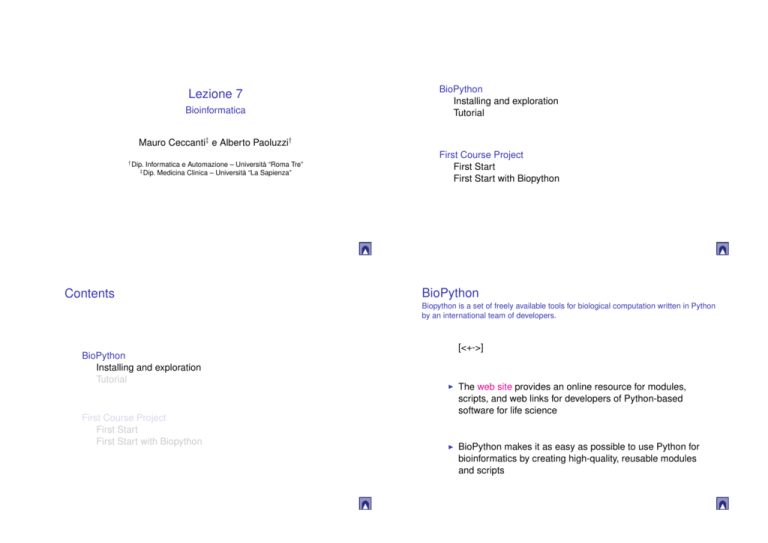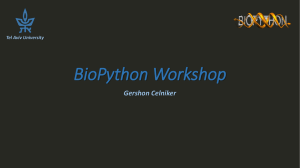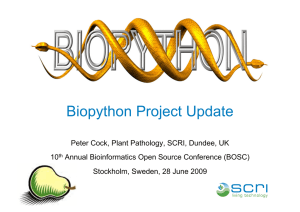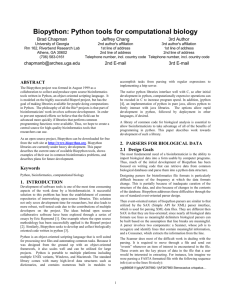Lezione 7 Contents BioPython - Dipartimento di Informatica e
advertisement

Lezione 7 Bioinformatica Mauro Ceccanti‡ e Alberto Paoluzzi† † Dip. Informatica e Automazione – Università “Roma Tre” ‡ Dip. Medicina Clinica – Università “La Sapienza” Contents BioPython Installing and exploration Tutorial First Course Project First Start First Start with Biopython BioPython Biopython is a set of freely available tools for biological computation written in Python by an international team of developers. BioPython Installing and exploration Tutorial First Course Project First Start First Start with Biopython [<+->] � The web site provides an online resource for modules, scripts, and web links for developers of Python-based software for life science � BioPython makes it as easy as possible to use Python for bioinformatics by creating high-quality, reusable modules and scripts BioPython Download Biopython is a set of freely available tools for biological computation written in Python by an international team of developers. Current Release – 1.52 This wiki will help you download and install Biopython, and start using the libraries and tools http://biopython.org/wiki/Download Biopython installation Biopython installation Short version Long version [<+->] � installer for windows: download Python-2.6.2.msi � standard install on MacOSX, Linux and Unix: � download the source � from command line in a terminal: 1 2 3 > python setup.py build > python setup.py test > sudo python setup.py install � http://biopython.org/DIST/docs/install/Installation.html Biopython installation Contents Best version ;-) � 1 from a terminal, with easy_install package already installed: > easy_install -f http://biopython.org/DIST/biopython Biopython Tutorial and cookbook Biopython Tutorial and Cookbook by Jeff Chang, Brad Chapman, Iddo Friedberg, Thomas Hamelryck, Michiel de Hoon, Peter Cock, and Tiago Antão BioPython Installing and exploration Tutorial First Course Project First Start First Start with Biopython Biopython Tutorial and Cookbook Chapter 1 Chapter 2 Chapter 3 Chapter 4 Chapter 5 Chapter 6 Chapter 7 Chapter 8 Chapter 9 Chapter 10 Chapter 11 Chapter 12 Chapter 13 Chapter 14 Chapter 15 Chapter 16 Chapter 17 Chapter 18 Introduction Quick Start – What can you do with Biopython? Sequence objects Sequence Record objects Sequence Input/Output Sequence Alignment Input/Output, and Alignment Tools BLAST Accessing NCBI’s Entrez databases Swiss-Prot and ExPASy Going 3D: The PDB module Bio.PopGen: Population genetics Supervised learning methods Graphics including GenomeDiagram Cookbook – Cool things to do with it The Biopython testing framework Advanced Where to go from here – contributing to Biopython Appendix: Useful stuff about Python Biopython Package contents Biopython Package contents The main Biopython releases have lots of functionality, including: The main Biopython releases have lots of functionality, including: 1. Files in the supported formats can be iterated over record by record or indexed and accessed via a Dictionary interface. 1. The ability to parse bioinformatics files into Python utilizable data structures, including support for the following formats: � � � � � � � � � Blast output – both from standalone and WWW Blast Clustalw FASTA GenBank PubMed and Medline ExPASy files, like Enzyme and Prosite SCOP, including ‘dom’ and ‘lin’ files UniGene SwissProt 2. Code to deal with popular on-line bioinformatics destinations such as: � � NCBI – Blast, Entrez and PubMed services ExPASy – Swiss-Prot and Prosite entries, as well as Prosite searches 3. Interfaces to common bioinformatics programs such as: � � � Standalone Blast from NCBI Clustalw alignment program EMBOSS command line tools 4. A standard sequence class that deals with sequences, ids on sequences, and sequence features. 5. Tools for performing common operations on sequences, such as translation, transcription and weight calculations. Biopython Package contents PDB: Atomic Coordinate Entry Format Description The main Biopython releases have lots of functionality, including: Learn to parse PDB files, locally and on the web 1. Code to perform classification of data using k Nearest Neighbors, Naive Bayes or Support Vector Machines. 2. Code for dealing with alignments, including a standard way to create and deal with substitution matrices. 3. Code making it easy to split up parallelizable tasks into separate processes. 4. GUI-based programs to do basic sequence manipulations, translations, BLASTing, etc. 5. Extensive documentation and help with using the modules, including this file, on-line wiki documentation, 6. the web site, and the mailing list. 7. Integration with BioSQL, a sequence database schema also supported by the BioPerl and BioJava projects. Protein Data Bank Contents Guide � Introduction � Title Section � Primary Structure Section � Heterogen Section � Secondary Structure Section � Connectivity Annotation Section � Miscellaneous Features Section � Crystallographic and Coordinate Transformation Section � Coordinate Section � Connectivity Section � Bookkeeping Section Contents First project Curation of records of PDB files of aminoacids Start from: BioPython Installing and exploration Tutorial Amino Acids web page First Course Project First Start First Start with Biopython and Library of 3-D Molecular Structures, in particular from Amino Acids Section Contents Start using Biopython Importing the package BioPython Installing and exploration Tutorial 1 2 3 Python 2.6.3 (r263:75184, Oct 2 2009, 07:56:03) [GCC 4.0.1 (Apple Inc. build 5493)] on darwin Type "copyright", "credits" or "license()" for more information. 4 First Course Project First Start First Start with Biopython 5 6 7 8 9 IDLE 2.6.3 >>> import Bio >>> print Bio.__version__ 1.51 >>> Start using Biopython Start using Biopython help() on the package import the PDB package 1 2 >>> help(Bio) Help on package Bio: 3 4 1 2 3 NAME Bio - Collection of modules for dealing with biological data in Python. 5 6 7 FILE /Library/Frameworks/Python.framework/Versions/2.6/ lib/python2.6/site-packages/biopython-1.51-py2.6macosx-10.3-fat.egg/Bio/__init__.py 8 9 10 11 12 DESCRIPTION The Biopython Project is an international association of developers of freely available Python tools for computational molecular biology. >>> from Bio.PDB import * >>> dir() [’AbstractPropertyMap’, ’Atom’, ’Bio’, ’CaPPBuilder’, ’ Chain’, ’DSSP’, ’Dice’, ’Entity’, ’ExposureCN’, ’ FragmentMapper’, ’HSExposure’, ’HSExposureCA’, ’ HSExposureCB’, ’Model’, ’NeighborSearch’, ’ PDBExceptions’, ’PDBIO’, ’PDBList’, ’PDBParser’, ’ PPBuilder’, ’Polypeptide’, ’Residue’, ’ResidueDepth’, ’Select’, ’Selection’, ’Structure’, ’ StructureAlignment’, ’StructureBuilder’, ’ Superimposer’, ’Vector’, ’__builtins__’, ’__doc__’, ’ __name__’, ’__package__’, ’calc_angle’, ’ calc_dihedral’, ’extract’, ’get_surface’, ’is_aa’, ’ m2rotaxis’, ’make_dssp_dict’, ’mmCIF’, ’ parse_pdb_header’, ’refmat’, ’rotaxis’, ’rotaxis2m’, ’rotmat’, ’standard_aa_names’, ’to_one_letter_code’, ’vector_to_axis’] 13 http://biopython.org 14 15 PACKAGE CONTENTS Affy (package) 18 Align Biopython (package) Start using 19 AlignAce (package) help() onAlignIO the package 20 (package) 21 .... 16 17 1 2 >>> help(Bio.PDB) Help on package Bio.PDB in Bio: Start using Biopython help() on the module Atom 1 2 3 4 NAME Bio.PDB 5 6 7 8 3 FILE 4 /Library/Frameworks/Python.framework/Versions/2.6/ lib/python2.6/site-packages/biopython-1.51-py2.6macosx-10.3-fat.egg/Bio/PDB/__init__.py 9 10 11 12 13 14 15 16 5 >>> Atom <module ’Bio.PDB.Atom’ from ’/Library/Frameworks/Python. framework/Versions/2.6/lib/python2.6/site-packages/ biopython-1.51-py2.6-macosx-10.3-fat.egg/Bio/PDB/Atom .pyc’> >>> from Bio.PDB.Atom import * >>> help(Bio.PDB.Atom) Help on module Bio.PDB.Atom in Bio.PDB: 6 7 NAME Bio.PDB.Atom - Atom class, used in Structure objects . 8 DESCRIPTION Classes that deal with macromolecular crystal structures. (eg. PDB and mmCIF parsers, a Structure class, a module to keep a local copy of the PDB up-to-date, selective IO of PDB files, etc.). Author: Thomas Hamelryck. Additional code by Kristian Rother. 9 10 11 FILE /Library/Frameworks/Python.framework/Versions/2.6/ lib/python2.6/site-packages/biopython-1.51-py2.6macosx-10.3-fat.egg/Bio/PDB/Atom.py 12 13 14 15 16 CLASSES Atom Bio.PDB.Entity.DisorderedEntityWrapper DisorderedAtom Start using Biopython Look the atom.py file ... 1 2 3 4 # Copyright (C) 2002, Thomas Hamelryck (thamelry@binf.ku .dk) # This code is part of the Biopython distribution and governed by its # license. Please see the LICENSE file that should have been included # as part of this package. 5 6 7 # Python stuff import numpy 8 9 10 11 # My stuff from Entity import DisorderedEntityWrapper from Vector import Vector 12 13 __doc__="Atom class, used in Structure objects." 14 15 16 17 18 class Atom: def __init__(self, name, coord, bfactor, occupancy, altloc, fullname, serial_number): """ Atom object. 19 The Atom object stores atom name (both with and without spaces), coordinates, B factor, occupancy, alternative location specifier and (optionally) anisotropic B factor and standard deviations of B factor and positions. 20 21 22 23 24 @param name: atom name (eg. "CA"). Note that spaces are normally stripped. @type name: string 25 26 27 28 29 ... ...



